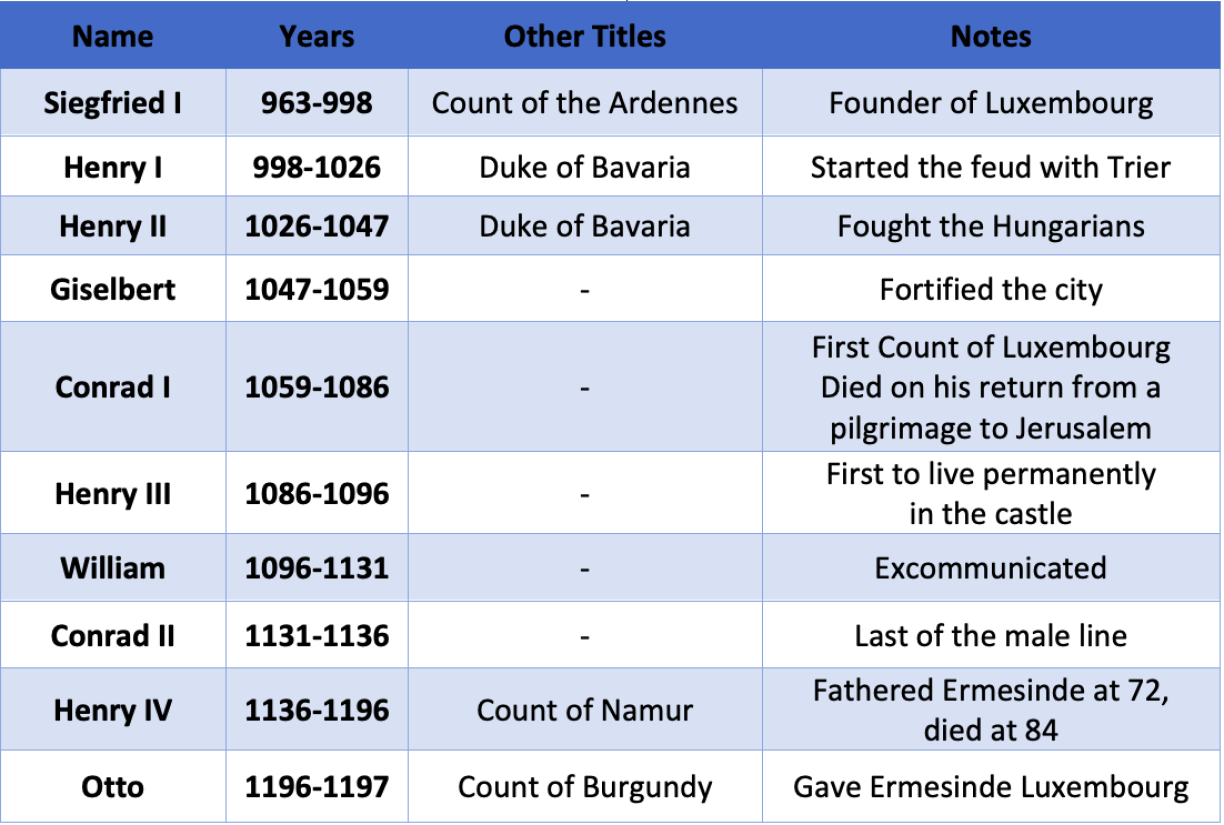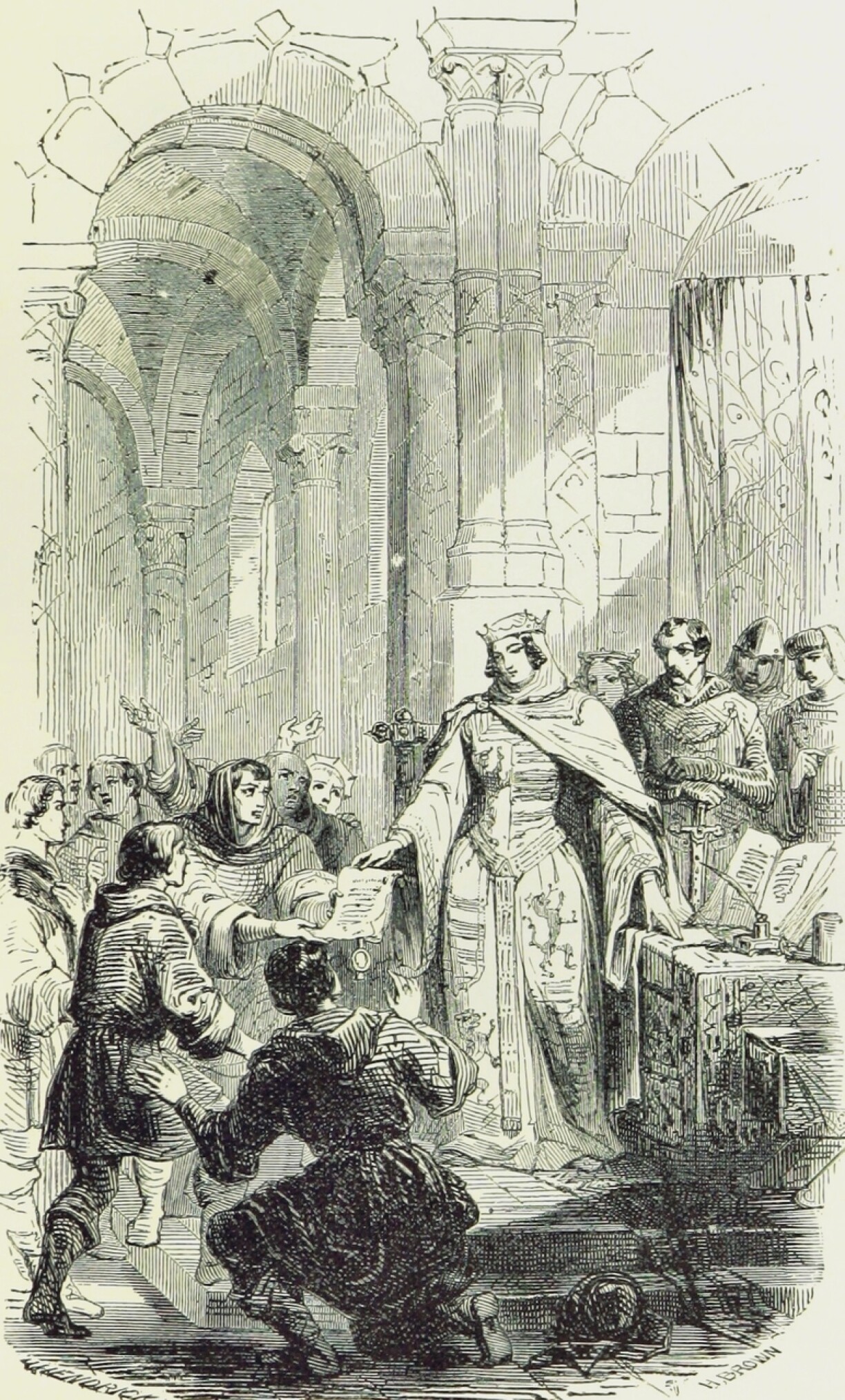
Don’t know your Giselberts from your Ermesindes? Don’t worry, RTL Today are here to help.
Listen to this episode right here or continue reading down below.
Although Siegfried is traditionally credited with founding Luxembourg, it’s important to specify that this refers to the town of Luxembourg, not the country.
In 963, Siegfried acquired an ancient Roman fortification on the Bock and transformed it into a castle. He and his grandsons styled themselves as the Counts of the Castle of Luxembourg.
It wasn’t until Conrad I, who succeeded his father Giselbert in 1059, that the title “Count of Luxembourg” – or its various medieval spellings like Luccelemburc or Luzelenburch – began to be used consistently. Medieval writers were often flexible with spelling conventions.
The rulers of Luxembourg and the archbishops of Trier were at odds for much of the early second millennium.
Siegfried acquired significant patronage over key monasteries and churches in the region, including the renowned abbey of St. Willibrord at Echternach and the abbey of St. Maximin in Trier. This led to a prolonged conflict with the archbishop of Trier over the right to appoint the abbot of St. Maximin.
The animosity began when Henry I of Luxembourg and Count Frederick of Moselle, Siegfried’s sons, revolted against Holy Roman Emperor Henry II, who was married to their sister Cunigunde. The brothers sought to control the archbishopric of Trier but were defeated by Henry II. Consequently, Trier came under the control of Poppo von Babenberg in 1016.
While Henry I and Frederick were later preoccupied with their roles as Dukes of Bavaria and their conflicts with the Hungarians, the struggle with Trier continued. When Henry II’s brother Giselbert succeeded him in 1047, he resumed the fight against the archbishops of Trier.
Giselbert’s son, Conrad I, the first Count of Luxembourg, made a fateful decision to kidnap the archbishop of Trier, which led to his excommunication. In an attempt to atone for his actions, Conrad undertook a pilgrimage to Jerusalem but tragically died on the return journey.
Conrad’s second son, William, also faced difficulties with Trier, resulting in his own excommunication.
By 1136, the male line of Siegfried came to an end with William’s son, Conrad II. Luxembourg then passed to Conrad’s cousin, Henry IV of Namur.
Upon assuming control of Luxembourg, Henry promptly engaged in a war with the Archbishop of Trier. Although he lost this conflict, marking the end of the long-standing feud between the two parties, he managed to acquire the Counties of Durbuy and Laroche, in addition to Namur and Luxembourg.
This union of territories helped to introduce French influence into Luxembourg, which had previously been aligned with the German-speaking archbishopric of Trier.
The first Countess of Luxembourg is remembered with great affection in the Grand Duchy.
She was the daughter of Henry IV, who fathered her at the age of 72. At just 11 or 12 years old, she married Theobald, Count of Bar. After her father’s death in 1196, Ermesinde and Theobald successfully purchased the County of Luxembourg from Otto, Count of Burgundy.
Still quite young, Ermesinde largely entrusted the management of the County to her husband until his death in 1214. She then married Waleran III, who would soon become Duke of Limburg, and remained with him until his death in 1226.

From then until 1247, Ermesinde ruled alone and earned a place in Luxembourgish history as a second founder of Luxembourg.
She governed her county with skill, introducing innovative administrative techniques. Her most notable achievements include granting charters of freedom to the towns of Echternach in 1236 and Luxembourg in 1244, which remain significant landmarks in her legacy.
In 1288, during the War of the Limburg Succession, Henry VI of Luxembourg, Ermesinde’s grandson, fought alongside the Archbishop of Cologne.
Unlike many medieval battles, which were often less deadly for noblemen – who typically sent their peasants into battle and were captured and ransomed if defeated – the Battle of Worringen was particularly brutal. Henry VI and three of his brothers were killed in the conflict.
As a result, Luxembourg fell into the hands of the young Henry VII, just 11 years old at the time. Despite the challenges of his early reign, Henry VII survived to become the first Holy Roman Emperor from the House of Luxembourg. His son, John the Blind, is remembered for founding the Schuberfouer, a notable event in Luxembourg’s history.
John the Blind’s son, Charles I of Luxembourg, achieved significant titles: he was elected King of the Romans in 1346, became King of Bohemia in the same year, and later assumed the titles of King of Italy and Holy Roman Emperor.
With such a demanding schedule, Luxembourg was not his main focus. In 1353, Charles decided to transfer control of Luxembourg to his brother Wenceslaus.

Additionally, Charles I decided that his brother Wenceslaus deserved more than just the title of count. In 1354, he elevated Wenceslaus’s holdings by merging the lands surrounding Luxembourg – Arlon, Durbuy, Laroche, Thionville, Bitburg, and Vianden – into the Duchy of Luxembourg.
This newly established duchy would endure until 1795.
And so, the splendidly medieval County of Luxembourg came to an end.
Thank you for tuning in! Now what are you waiting for – download and listen, on iTunes, Spotify, or wherever you get your podcasts.